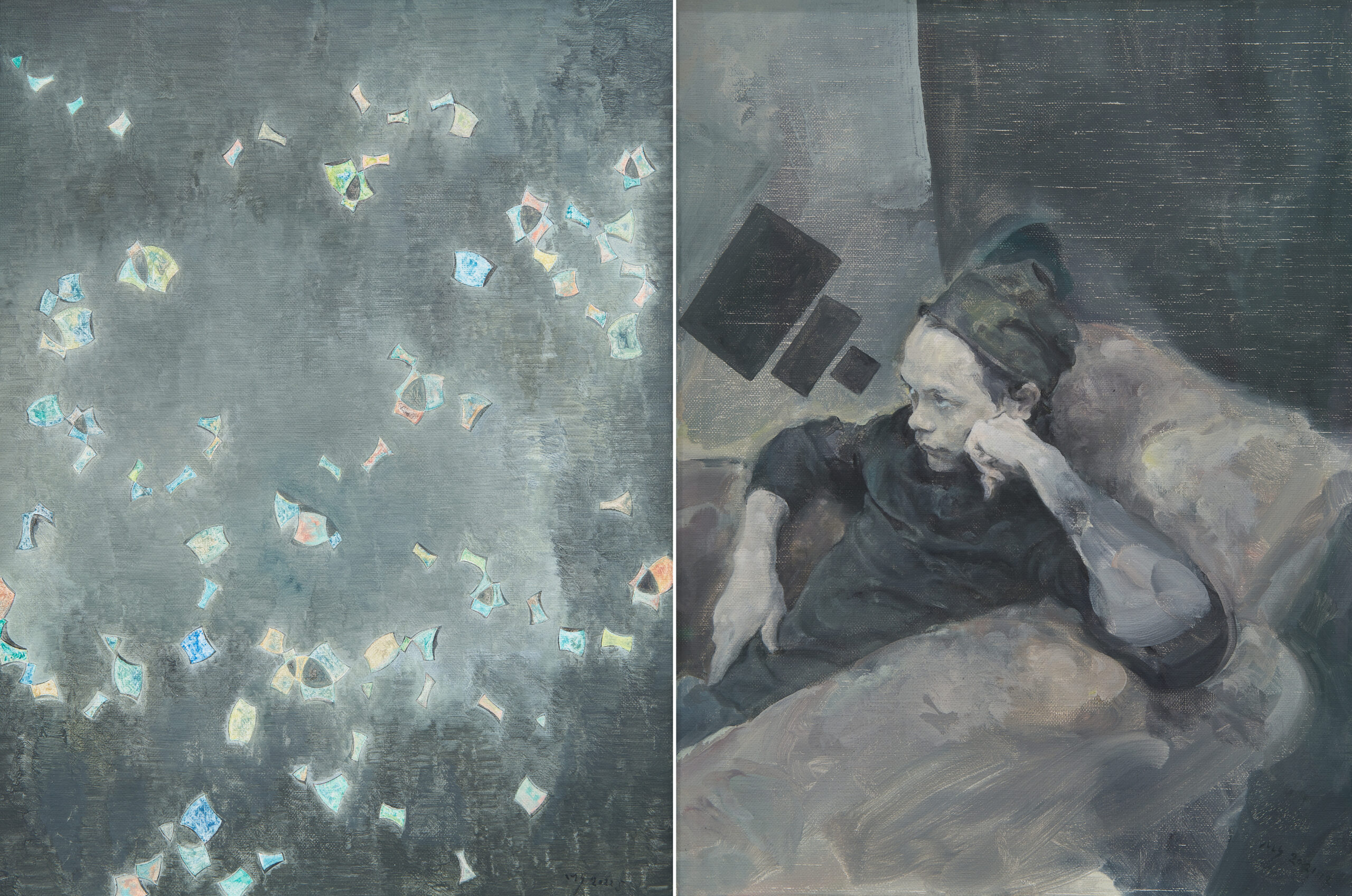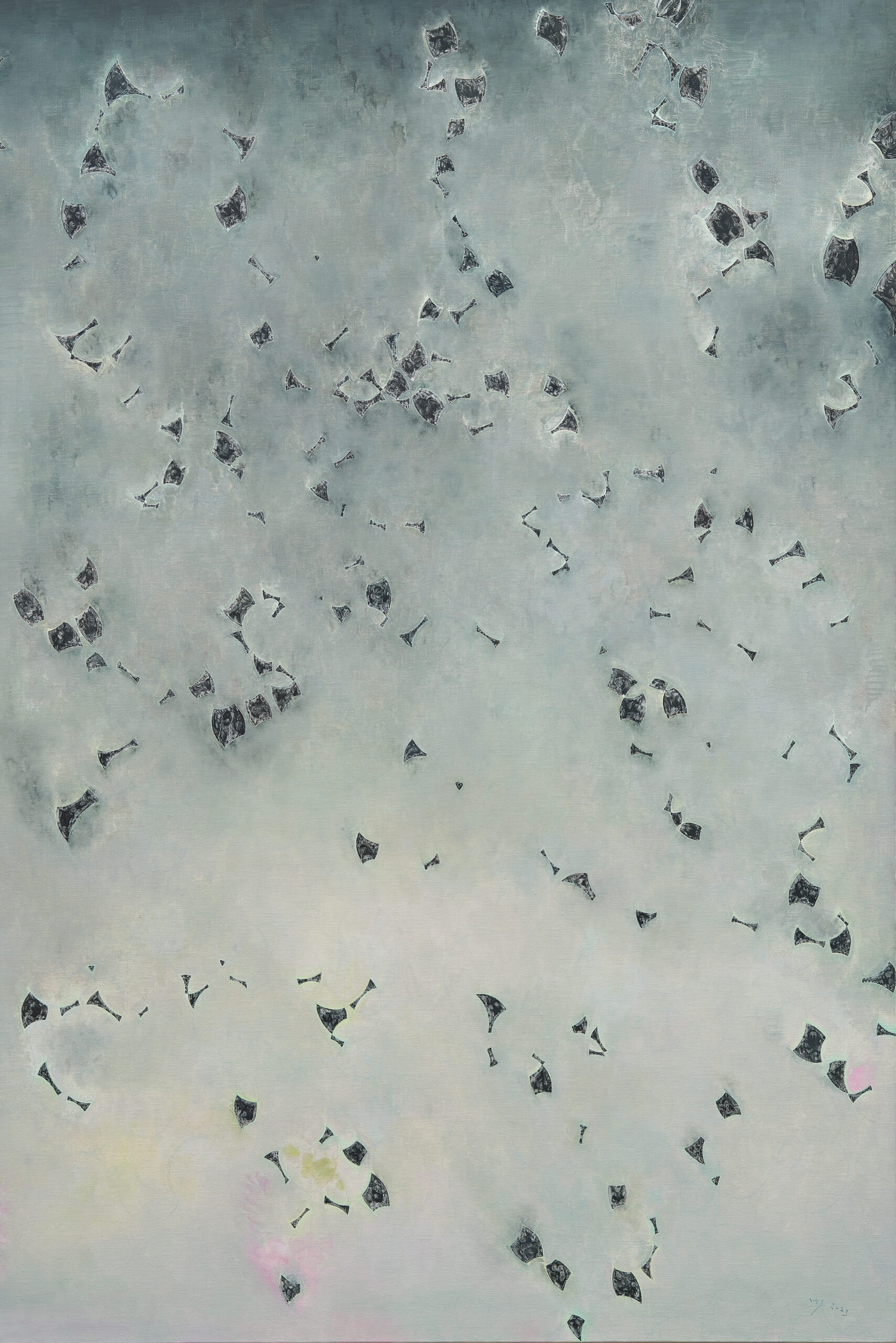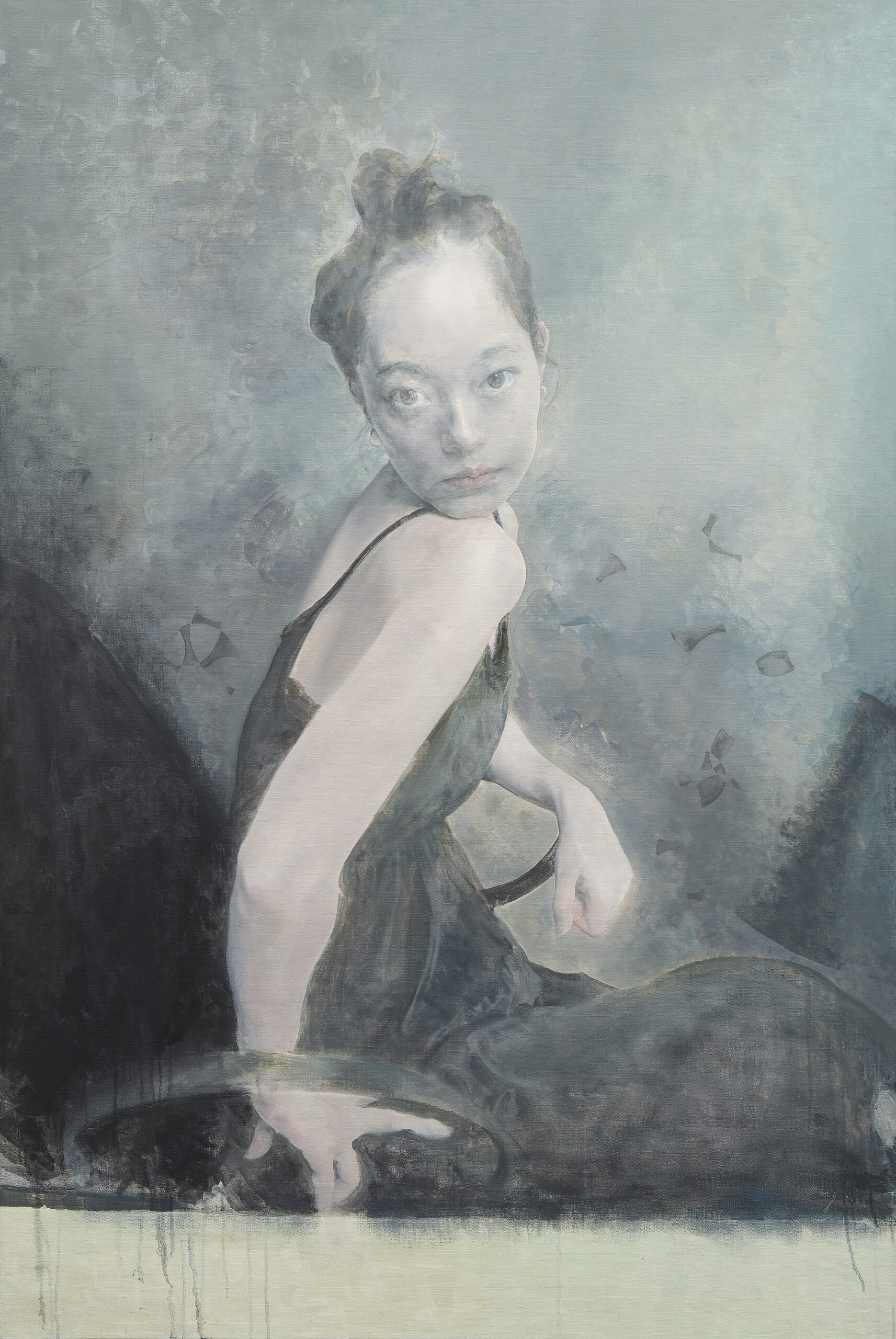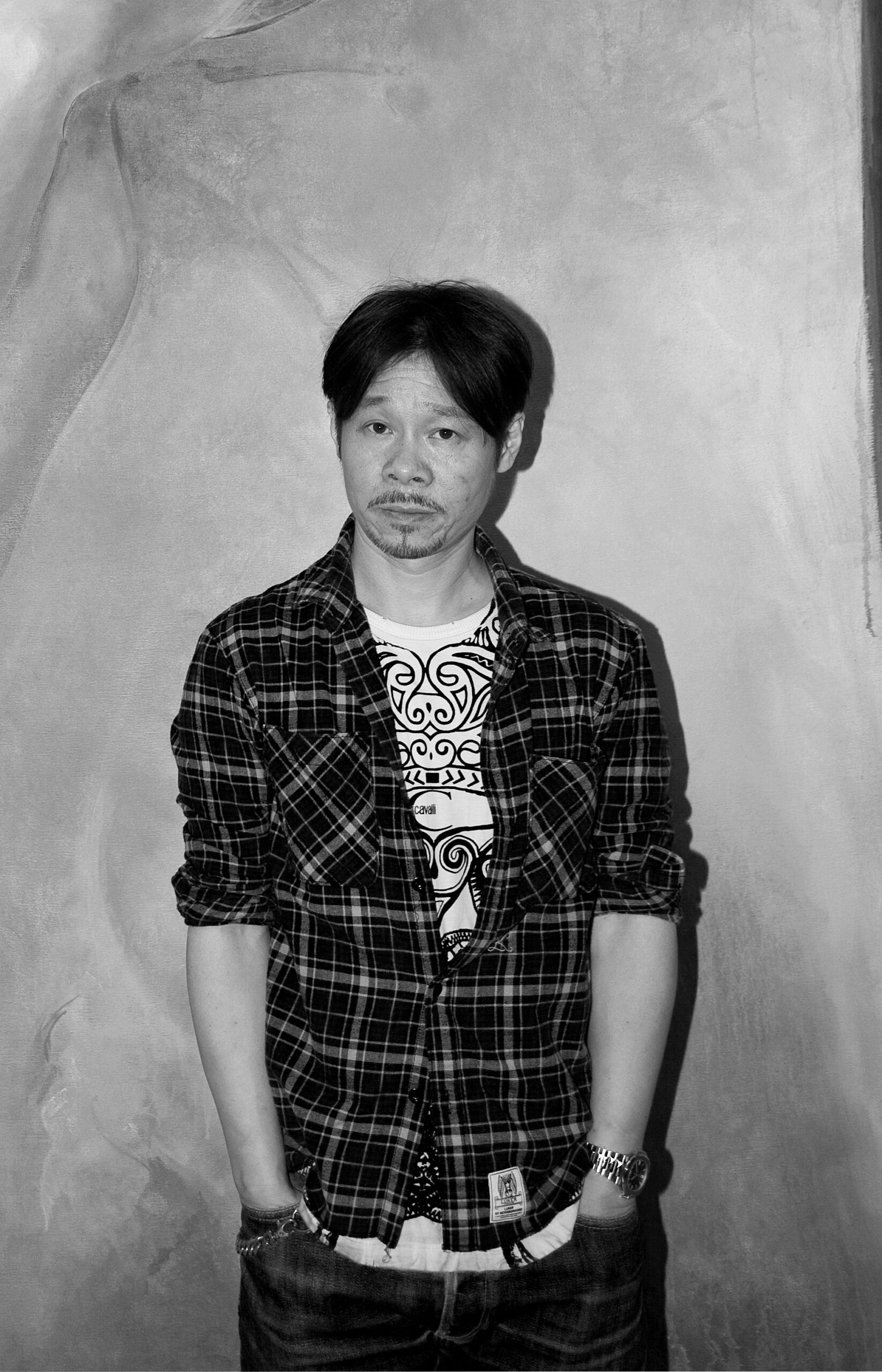
“When you pay attention to a portrait for a long time, he or she is a mirror of your own, and the dialogue with yourself, or monologue, is also full of self-examination.” Mao Yan tells me about his latest body of work in his debut solo exhibition in the UK, New Paintings, previously on display at Pace in London. The paintings are a mix of both abstract and figurative works; solitary figures command attention from various perspectives, their piercing gaze unwavering. The abstract works have an illusionistic quality with juxtaposing sharply defined fragments. Our conversation spans a number of topics, including memory and perception, traces of the past that are extrapolated throughout scenes of overwhelming presence of absence, art history and refining an artistic medium over a long period of time.

I ask Mao Yan to elaborate on the convergence of abstract and figurative paintings. He explains that the intersection between the two is “instinctive… you want to blend them, and all that’s left is how to adapt, how to be consistent within, and let things flow in a very natural way,” giving an example for the work Master Hongyi and Mariewicz (2021), “in fact, the white wall reserves the space for a black square, and it’s just right.” The small painting is a portrayal of Master Hongyi – a Chinese master painter and the first Chinese educator to use nude models in his painting classes – dressed in monk’s attire and resting on a bed within a small bedroom setting. Behind him and hung at an angle is a copy of Kazimir Malevich’s Black Square (1915), a work that marks a shift in the evolution of modern art. Throughout the New Paintings, familiar objects and materials are rendered unfamiliar, and this is compounded by their mise-en-scène setting. The Little Daimao paintings of cats, placed in a corner of the gallery space, hived off as some of the final paintings to encounter, is an example of familiar subjects or objects are hived off from the world as we know it, and placed in other-worldly environments lacking a temporal system. In Eye and Mind (1964), French phenomenological philosopher Maurice Merleau-Ponty asserts the painter retains a unique capacity to project perception of the world onto the canvas, evoking “the second power, a carnal essence or icon of the first” through the paintbrush. Merleau-Ponty collapses the Cartesian dualism of body and mind, and thereby, the Cartesian distinction between perception as sensation and perception as interpretation. To touch an object is neither simply a sensory experience nor an intellectual experience. Rather, the sensory experience is mediated through the body, the medium of our interpretative perception of the world. This reversibility “encroaches” into our perception and is significant when analysing our role as the spectator. Mao Yan places the viewer within his paintings – although his subjects are collected from his own life, from photographs of his family, relatives, friends – he specifies that his subjects are not “single specific individuals.” The spectator is given room to reflect on their own lived experience, one wherein they can enmesh or mould the self with the other. The New Paintings are a model of the past and the present co-existing.


Memory plays an essential role in both the creation and the viewing experience of paintings and serves as a central theme in Mao Yan’s work. Driving his investigation into the complex interplay between personal and collective recollection and the construction of identity, his process is inextricably linked to an act of patience. In his Nanjing studio, he takes his time – sometimes years – to create his compositions. He talks through a timeline of his process: “The beginning is the most enjoyable and satisfying, the middle process is long and tangled, and the end is endless,” explaining that it is the preparation that takes him the longest: “to choose specific models […] I want them to have both personal qualities and a certain level of abstract potential, to be an individual, or many, within the same portrait.” There is a sense that Mao Yan keeps a certain distance from his subject matter. One stand-out painting in the show is Madam (2022), a portrayal of a young girl dressed in black, her direct frontal gaze gently challenging the viewer. Leaning into the frame, her face sharply angled over her right shoulder, she rested her chin towards us. Against a mottled, pale grey backdrop, her delicately drawn features convey her youthfulness, though the painting captures both vulnerability and strength. Similarly, two portraits of young men exude luminosity, their presence commanding attention. In Young Man in a Hat No.2 (2021), a small figure is enveloped in a large armchair, his gaze unwavering. Above his face, a trio of black rectangular forms disrupts the scene. Mao Yan’s compositions serve to heighten the spectatorial experience of perception. His desire is to tease the viewer, placing them inside the inaccessible interior space through accessible imagery and metaphors, all associated with domesticity. He attends to the viewers’ position as see-er and seen.
His practice is a fusion of Eastern and Western influences, deeply rooted in art historical references. Inspired by both Old Masters and traditional Chinese painting techniques, Mao Yan adeptly navigates the intersection of cultural influences with sensitivity. Speaking on these influences, he remarks, “I don’t care too much about how many influences intersect in the work; they affect me in different situations; some are clearly discernible, some are vague and distant, some involve principles, and some are just thoughts. Generally speaking, classical painting has a profound influence on me. Sometimes, I just need to look at some of the works of my favourite masters, and I will know what to paint next; it’s my habitual process.” This synthesis is evident in his work’s emotional resonance and technicality reminiscent of Old Masters like Jan van Eyck, as well as in its emphasis on spiritual contemplation and expression of inner emotions, characteristic of traditional Chinese painting influenced by Confucian, Daoist, and Buddhist philosophies.

After dedicating over three decades to his practice following his graduation from the Central Academy of Fine Arts, Beijing, in 1991, his subdued colour palette has developed over time – a grey, sea moss green – that contributes to the sense of unease and disquietude in his work. “During the pandemic, I stopped oil painting for two years and developed my ink on paper works. In this exhibition, Broken Teeth and Condensed or Adrift series, I further developed my ink works, evolving and adding new forms and logic to my work. Of course, these works are also the accumulation of many perceptions and emotions. Throughout my experience, I have always rejected what is called inspiration.” The abstract works are built up of fragmented components, not teeth as the title suggests, but something bodily, again hinting at our ability to interpret the world through our bodily experiences. When working with oil paint, Mao Yan creates a sfumato effect, a ‘smoky’ quality which blurs contours so that figures emerge from a dark background by means of gradual tonal modulations without any harsh outlines. Leonardo da Vinci advised painting ‘without lines’ in his uncompleted treatise on painting, and this atmospheric quality can be seen in his own works. It was also introduced in Venice by Giorgione, whose paintings show such subtle transitions of tone that the figures almost fuse with their surroundings. He wants to take his colour palette further, explaining that he is “starting a series where I use deeper hues. Previously, the theme was focused on grey hues, but now it is about the deeper aspects of colour.”

Mao Yan’s dedication to his craft shines through in his unwavering commitment to constant sensitivity and growth in the studio. Asking him about any challenges that he faces in the studio, Mao Yan tells me, “There are no specific challenges; the only requirement I have for myself is to be constantly and highly sensitive to everything during my painting process.” The ‘New Paintings’ exhibition at Pace has given Mao Yan the chance to reflect and look forward to the next body of work, which will begin with revisiting one particular portrait: “I completed the first draft of it four years ago, and since then left it untouched. I am now beginning to work on it again. However, it is evolving very differently.” His next series of work focuses on “portraits of my three best friends […], but I’m still trying to figure out how to proceed on them.” It is evident that his artistic journey is one of evolution and exploration; with each brushstroke, Mao Yan delves deeper into the complexities of portraiture and abstraction, breathing new life into long-dormant works with a fresh perspective.
Written by Sofia Hallström





